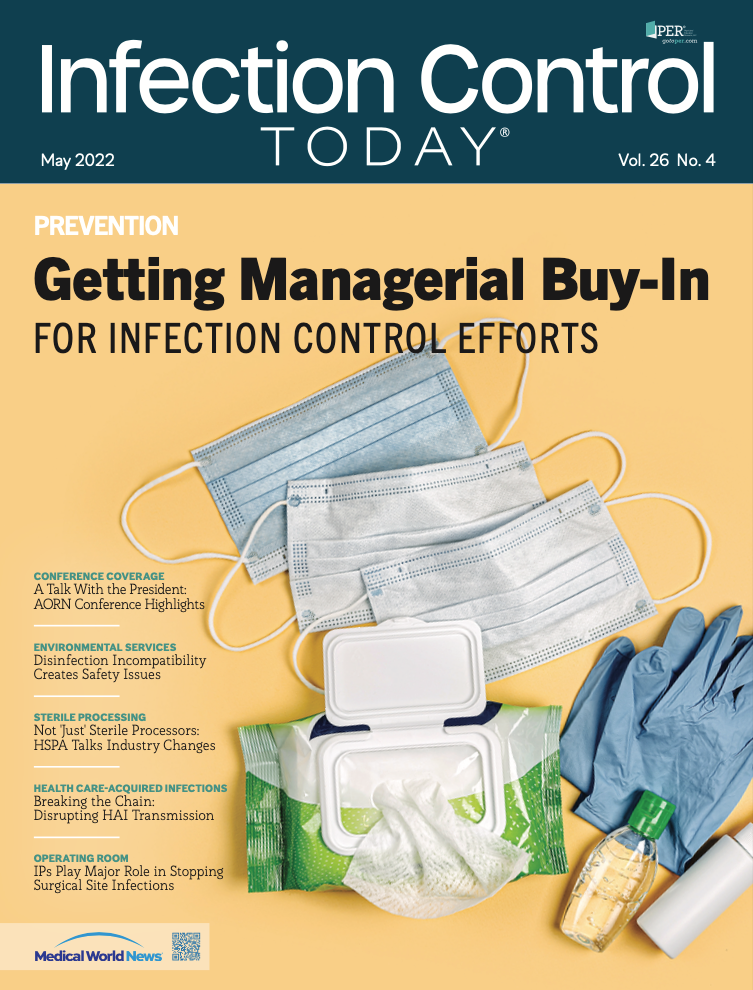Getting Managerial Buy-In for Infection Control Efforts
Health care workers' adherence to guidelines and overall job satisfaction are influenced by the level of support they feel they receive from their management team.
(Adobe Stock)

In the 15th century, Niccolò Machiavelli, a politician who is famous for his canny strategic advice, wrote, “There is nothing more difficult to take in hand, more perilous to conduct, or more uncertain in its success than to take the lead in the introduction of a new order of things.”
This is still true. Say you’re trying to get a hand hygiene intervention tested in your hospital. You know there’s a clear need. You have historical and current data about infection incidence, you have anecdotal evidence from staff and patients, and you’ve seen with your own eyes how often the guidelines are breached. However, the people running the place don’t see it the same way, which is the problem you’d like to solve. What do you do?
Study after study of infection prevention and control (IPC) interventions and programs have concluded that you don’t get far without management support. Such support can take many forms, including funding for the project, communication about the project, and visible backing for the project. There is no question that to execute a project successfully, a team must be well rounded, with representation ideally from all stakeholders. That includes leadership.
It’s usually easy to find out where and why management support might be needed. Just ask the staff. For example, a Cochrane review observed 20 studies exploring the views of health care workers (HCWs) on adherence with IPC guidelines for respiratory infectious diseases.1 The HCWs said they weren’t sure whether to follow local guidelines if those differed from national guidance. They struggled to follow long or unclear guidelines, especially if the advice kept changing. In fact, nurses in one study termed impractical guidance as inflexible IPC. They pointed to a lack of training about infection and how to use personal protective equipment.
One of the top findings was that adherence was influenced by the level of support HCWs felt they received from their management team. HCWs who perceived that hospital administration and managers were supportive and who openly demonstrated that support were more willing to engage with IPC. For example, one nurse was quoted, saying “The practice by administrators of making rounds on the units and offering words of encouragement was perceived as being supportive of staff.”
Other investigators who reviewed 56 papers on HCWs’ adherence with infection control (IC) measures found that leading by example was key—not just setting standards for IC practices but reinforcing them.2 Communication, verbal and nonverbal, is perhaps the most important variable when you need to get parties of any kind to go along with something. “When I’ve encountered barriers along the way of opposition, it usually ends up being a case of miscommunication or misunderstanding. That is why communication with all impacted stakeholders is so important at the beginning,” Rebecca Leach, MPH, BSN, RN, CIC, told Infection Control Today®.
Leach, who is the director of infection prevention at a level 1 trauma center in Phoenix, Arizona, has experience in both trying to implement infection prevention (IP) practices and getting support from leadership to invest resources to build the IP program. “Implementing change brings about anxiety, which is a natural response,” she said. “It’s easy to get frustrated with a person or group who seems resistant. However, we have to be a bit of a psychologist and try to understand what the underlying fears are associated with the proposed change.”
It can also help to consider managerial style. Managerial styles reflect how the best managers “will achieve strategic goals through task assignment and resources allocation, and how they will use management information for controlling and monitoring the achievement of different strategic policies,” according to David Naranjo-Gil, of the Universidad Pablo de Olavide in Sevilla, Spain.3 For instance, the style might be proactive or interactive, focusing on solving problems before they have a chance to appear. Or it might be reactive or diagnostic, focused on responding to events after they have appeared.
“A proactive managerial style involves debate and dialogue among managers and subordinates at different organizational levels, which stimulates opportunity-seeking, proactive behaviors and encourages the development of new activities and actions. In contrast, a reactive or diagnostic managerial style focuses on controlling efficiency of prescribed tasks and on monitoring organizational outputs by comparison with preset standards to analyze potential deviations and correct them to achieve the intended strategic goals,” Naranjo-Gil wrote.
If you want to introduce a project, you need leadership to agree. But it isn’t enough to get a “go ahead”—you need commitment. “Countless quality and safety initiatives are launched with good intent but wither on the vine because of a lack of effective leadership,” said investigators from the Vanderbilt University Medical Center (VUMC) in Nashville, Tennessee.4 They launched a system-wide initiative aimed at achieving and sustaining hand hygiene (HH) adherence and reported on the implementation and impact. Based on their experience, they recommend that project leaders continuously evaluate health system leadership support. Some questions they found critical to evaluating commitment include the following:
- Is the project consistent with the system’s quality and safety priorities?
- Does financial support exist, including support for key personnel?
- Are system leaders willing to publicly affirm commitment to the goal and its associated metrics?
- Are leaders willing to address nonadherent individuals?
“Too often, system leadership support is signaled initially but then disappears once difficult decisions arise, undercutting the authority of the project team,” the investigators said. To forestall that, before beginning the VUMC HH program, they secured leadership commitment. When individuals resisted elements of the HH plan, VUMC leadership was prepared and responded “in a measured and effective way.”
Of course, even with willing participants on all sides, it’s not uncommon to run into obstacles, such as a promising avenue getting blocked or support suddenly disintegrating. You find that Option A doesn’t work against Obstacle A, so you try Option B, then come up against Obstacle C. “This is typically where I apply the PDSA [Plan-Do-Study-Act] cycle,” Leach said. The PDSA cycle is a process for testing, evaluating, and improving a project or product.
“With every new initiative or proposal to leadership, I do my best to anticipate the barriers, pull together key stakeholders ahead of time to get more information, and try to have a plan in place before things are implemented,” Leach said. “Of course, you will always have something come up or a plan that doesn’t work. One thing is not to take it personally, because we are working with humans, and you cannot control all the variables. Keeping flexibility, keeping your stakeholders engaged, and being open to changing the course to address new barriers is important.”
Some obstacles are recurrent. In fact, they might be said to be endemic. “Financial barriers are never a surprise, because typically, IP departments do not have budgets beyond personnel, so it is never our money being used for new products or to help implement change,” Leach said. The most common obstacle “tends to be competing priorities,” she said. “There are always several quality and safety initiatives going on at the same time, as well as other organizational challenges, such as staffing.”
When Leach runs into that kind of recurrent issue, her practice is “to try to meet the team where they are, listen to what they perceive as barriers, and figure out how to integrate HAI [health care–acquired infection] prevention into everyday practices. Also by building trust and relationships and telling stories. Telling staff stories about patients they’ve cared for can be very impactful.” Basically, she gives a case summary about the patient, including what happened to them, where they went, and what their state upon discharge was.
What if the issue is not just about getting interventions or projects approved but about justifying the need for your entire department? “A few years ago, our [IPC] department was on the chopping block to reduce its size. We were 8 IPs covering a 900-bed acute care academic medical center with 5 other hospitals in our system,” one IP told ICT®. The IP team was more than surprised. “The need to justify the existence of our department rocked our world.”
The main obstacle was the fact that IP was not a revenue generator. “The ‘powers that be’ were looking for ways to save money,” the IP said. “Fortunately, our medical director was determined to keep the staff and department. She began building a case based on patient safety—the main reason [IPC] exists—by outlining costs of HAIs. We listed everything IC laid hands on. We provided our medical director with a list of all the areas we covered, all the education we provided, all the surveillance we performed, all the construction projects we provided support to, [and] how closely we worked with risk and quality assurance, just to give a few examples. She was able to figure out how much money we saved the hospital by doing all the things we did.”
One of the more challenging tasks was “helping nonclinical decision makers understand all that infection prevention does,” the IP said. The main takeaway from the experience was that “everything comes down to money. If you can prove that your department—although not a revenue generator—saves the facility money, that’s a good start. Also be able to list [what] your department is involved in. That was a real eye-opener to the C-suite,” the IP said.
What’s the hardest part of getting buy-in? “Right now, the hardest part is that everyone is tired,” Leach said. “COVID-19 response has exhausted staff and leadership. [Although] many are eager to work on something other than COVID-19 response, we [must] acknowledge that there will be long-lasting impacts to the morale and mental health of HCWs. Similarly, we’ve had so much movement of staff, with people leaving, new graduates, travel staff, etc, [that there are now] so many new faces to educate...and try to bring into the fold.”
With so many variables to consider, including an overwhelming pandemic, there is always a potential for setbacks. Goals will change, great ideas will fall by the wayside, and you may need to pause and regroup again and again. But as the Taoist Sun Tzu teaches in The Art of War, choose your battles. “He will win who knows when to fight and when not to fight,” Sun Tzu wrote. Over 2000 years later, this is still a useful concept.
“Sometimes you will not be able to overcome a barrier, and then you try to compromise,” Leach said. “I pick my battles and make sure my perspective is adjusted and that it’s not just me pushing something because I think it’s the best way to handle the situation.” It can be a bitter pill to swallow, but sometimes you have to let go. You can’t win them all.
References
- Houghton C, Meskell P, Delaney H, et al. Barriers and facilitators to healthcare workers’ adherence with infection prevention and control (IPC) guidelines for respiratory infectious diseases: a rapid qualitative evidence synthesis. Cochrane Database Syst Rev. 2020;4(4):CD013582. doi:10.1002/14651858.CD013582
- Brooks SK, Greenberg N, Wessely S, Rubin GJ. Factors affecting healthcare workers’ compliance with social and behavioural infection control measures during emerging infectious disease outbreaks: rapid evidence review. BMJ Open. 2021;11(8):e049857. doi:10.1136/bmjopen-2021-049857
- Naranjo-Gil D. Accomplishing water strategy policies in hospitals: the role of management information systems and managerial styles. Water. 2017;9(2):107. doi:10.3390/w9020107
- Talbot TR, Johnson JG, Fergus C, et al. Sustained improvement in hand hygiene adherence: utilizing shared accountability and financial incentives. Infect Control Hosp Epidemiol. 2013;34(11):1129-1136. doi:10.1086/673445

Robust infectious disease surveillance, including rapid subtyping of influenza A, is essential for early detection, containment, and public health reporting of novel viral threats.